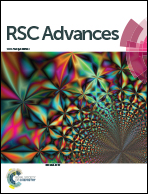Facile one-step hydrothermal synthesis of α-Fe2O3/g-C3N4 composites for the synergistic adsorption and photodegradation of dyes†
Abstract
With the expansion of industrialization, dye pollution has become a significant hazard to humans and aquatic ecosystems. In this study, α-Fe2O3/g-C3N4-R (where R is the relative percentage of α-Fe2O3) composites were fabricated by a one-step method. The as-prepared α-Fe2O3/g-C3N4-0.5 composites showed excellent adsorption capacities for methyl orange (MO, 69.91 mg g−1) and methylene blue (MB, 29.46 mg g−1), surpassing those of g-C3N4 and many other materials. Moreover, the ionic strength and initial pH influenced the adsorption process. Relatively, the adsorption isotherms best fitted the Freundlich model, and the pseudo-second-order kinetic model could accurately describe the kinetics for the adsorption of MO and MB by α-Fe2O3/g-C3N4-0.5. Electrostatic interaction and π–π electron donor–acceptor interaction were the major mechanisms for MO/MB adsorption. In addition, the photocatalytic experiment results showed that more than 79% of the added MO/MB was removed within 150 min. The experimental results of free-radical capture revealed that holes (h+) were the major reaction species for the photodegradation of MO, whereas MB was reduced by the synergistic effect of hydroxyl radicals (·OH) and holes (h+). This study suggests that the α-Fe2O3/g-C3N4 composites have an application potential for the removal of dyes from wastewater.



 Please wait while we load your content...
Please wait while we load your content...